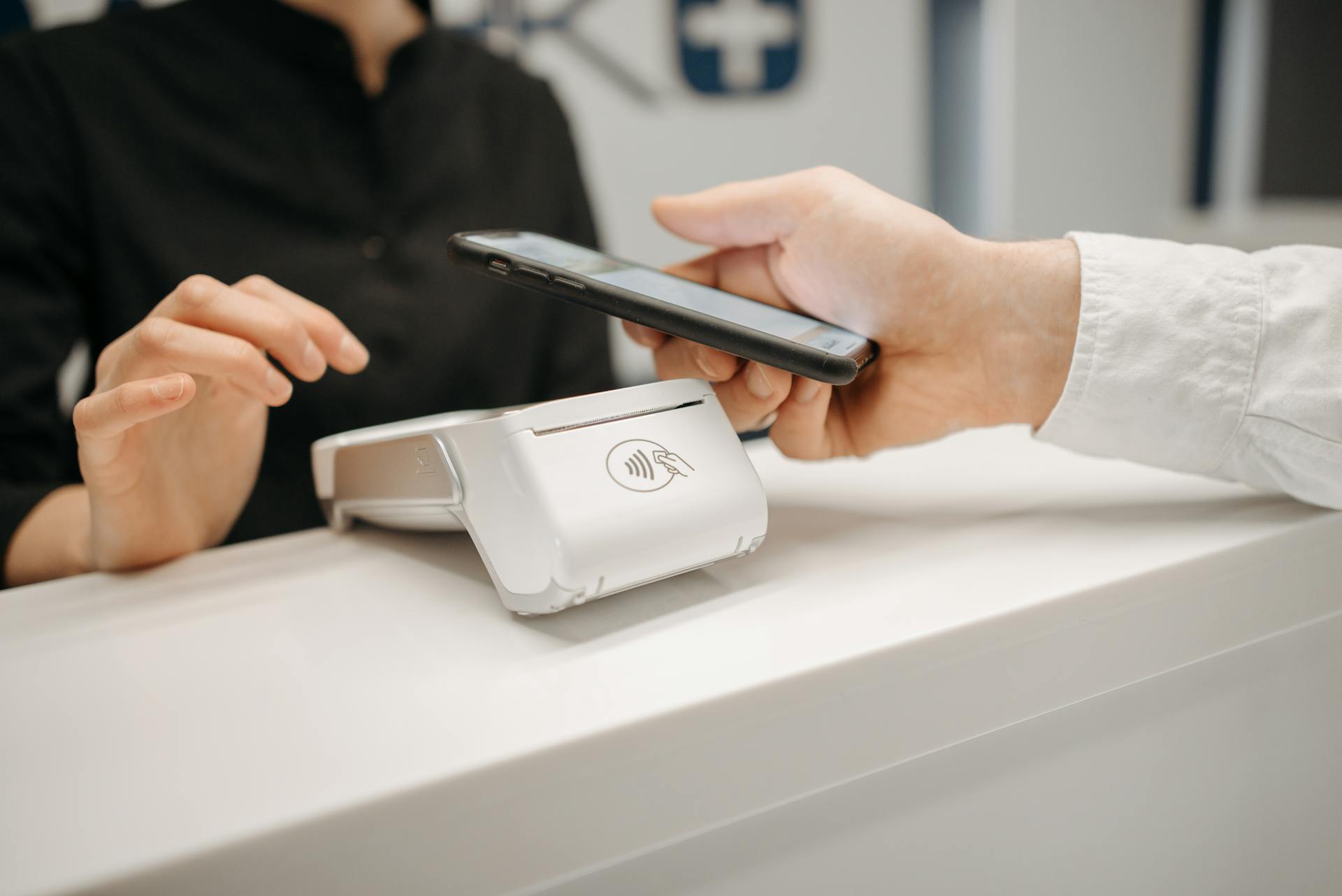
A loan against SBLC can be a complex financial transaction, but understanding its structure, requirements, and risks is crucial for a smooth experience.
The structure of a loan against SBLC typically involves a bank or financial institution issuing a Standby Letter of Credit (SBLC) to a borrower, which can then be used as collateral for a loan.
To qualify for a loan against SBLC, you'll need to meet certain requirements, such as having a strong credit history and a significant amount of collateral.
Banks and financial institutions often require a minimum credit rating and a substantial amount of collateral to secure a loan against SBLC.
The risks associated with loan against SBLC include the potential for the borrower to default on the loan, which can result in the loss of the collateral.
On a similar theme: Va Loan for Manufactured Housing Requirements
What Is Standby Letter of Credit
A Standby Letter of Credit (SBLC) is essentially a bank guarantee in a letter of credit format. It's a documentary credit or similar arrangement that represents an obligation to pay on account of any indebtedness undertaken by the applicant.
SBLCs are used as a substitute for financial guarantees, especially in countries like the USA and Japan where bank guarantees are not permissible.
The document called for under such credits is a simple statement of claim as a certificate of non-performance.
An SBLC works as a guarantee in the background of the underlying transaction and is expected to never be drawn.
Under the earlier structure, LOU/LOC (MT799) provided the underlying security against which overseas branches were funding the transaction.
SBLC Structure and Requirements
The SBLC structure can be a bit complex, but understanding its requirements can make a big difference. To start with, Buyers Credit against SBLC structure has to be approved internally by the bank before it's offered to the importer.
In most cases, the importer doesn't have SBLC limits in their existing sanction, which means the existing limits have to be modified. This can add an extra layer of complexity to the process.

The payment mode is also crucial, as not all payment modes are acceptable to overseas banks. For instance, direct documents and some other modes may not be acceptable to certain banks.
To navigate this, it's essential to structure the payment terms with due consideration, taking into account the LC, DA, DP, or direct documents options.
Here's a quick rundown of the steps to consider:
- Check if Buyers Credit against SBLC structure is approved internally by bank.
- Get SBLC limits sanctioned under existing limits as sub limit or get fresh limits sanction.
- Structure the payment terms (LC, DA, DP or Direct documents) with due consideration.
- Discuss with bank on the process and documentation that will be required from bank end.
Factors Determining Standby Letter of Credit Collateral Requirements
The collateral requirements for a standby letter of credit depend on the applicant's creditworthiness.
Banks may prefer liquid assets as collateral for an SBLC to ensure quick recovery in case the applicant defaults. Acceptable assets can include cash, marketable securities, or other easily monetizable assets.
The type of SBLC also plays a role in determining collateral requirements. A performance SBLC, which ensures contract completion, may require different collateral than a financial SBLC, designed as payment guarantee.
Issuing an SBLC can affect a company's credit lines, decreasing available credit or increasing collateral obligations. This reflects a contingent liability that could mature if the SBLC is drawn upon.
The perceived risk of the transaction is another factor that determines collateral requirements. The issuer might consider the company's ability to fulfill the contractual obligations when assessing collateral for a performance SBLC.
For another approach, see: What Are Collateralized Loan Obligations
Documents Required

To secure an SBLC, you'll need to gather a set of essential documents. The list of required documents can vary from bank to bank, but here's a generic list to get you started.
You'll need a Customer Request Letter to initiate the process. This letter should include all relevant details about the loan.
An Offer Letter is also a must-have, outlining the terms and conditions of the loan. It's crucial to have this document in place before proceeding.
A Loan Agreement, franked as per the respective state law, is another vital document. This agreement will serve as the foundation for the loan.
You'll also need to provide a copy of the Transaction Related Document. This document should include all the necessary details about the transaction.
In some cases, you may need to provide an Importer's Bank SBLC by SWIFT – MT760. This document is used to guarantee the payment of the loan.
Take a look at this: Convertible Loan Agreement
If the bank requires it, you'll need to provide an Importer's Bank Funding Request by MT799. This document is used to request funding for the loan.
A Verification and Confirmation Certificate from the Importer's Bank is also necessary. This certificate confirms the details of the loan.
If the bank doesn't require an MT799, you may need to provide a Repayment Schedule. This schedule outlines the repayment terms of the loan.
Finally, you may need to provide Trade Transaction Details if the bank doesn't require an MT799. This document includes all the necessary details about the trade transaction.
Here's a list of the required documents in a concise format:
- Customer Request Letter
- Offer Letter
- Loan Agreement (franked as per respective state law)
- Transaction Related Document copy
- Importer's Bank SBLC by SWIFT – MT760
- Importer's Bank Funding Request by MT799
- Verification and Confirmation Certificate (by Importer's Bank)
- Repayment Schedule (where MT799 is not asked for)
- Trade Transaction Details (where MT799 is not asked for)
Issues in SBLC Structure
There are several issues that can arise when dealing with the structure of a Standby Letter of Credit (SBLC). One of the main issues is that the Buyers Credit against SBLC structure has to be approved internally by the bank before it can be offered to the importer.
This can lead to delays and complications, especially if the importer doesn't have existing SBLC limits in their sanction. In such cases, the existing limits have to be modified, which can be a time-consuming process.
Not all payment modes are acceptable to overseas banks, which can further complicate the process. For example, some banks may not accept direct documents or even DA/DP mode.
Some banks are even issuing SBLCs only to their own overseas branches, and charging rates as high as 6 Month L+250 bps.
The time it takes to complete the transaction has also increased. Earlier, the process required only the issuance of a Letter of Undertaking (LOU) or Letter of Comfort (LOC), but now it requires the signing of a loan agreement, acceptance of an offer letter, and couriering originals to the overseas bank.
Additionally, banks will have to send MT760 and in some cases, MT799, which can add to the complexity of the process.
Here are the issues that can arise when dealing with SBLC structure:
- Buyers Credit against SBLC structure has to be approved internally by bank.
- Existing limits have to be modified if importer doesn't have existing SBLC limits.
- Not all payment modes are acceptable to overseas banks.
- Some banks are issuing SBLCs only to their own overseas branches.
- Time it takes to complete transaction has increased.
- Loan Agreement has to be executed for every transaction.
These issues can make the process of dealing with SBLCs more complicated and time-consuming than it needs to be.
SBLC Financing Options
SBLC financing options are designed to provide flexibility and security for import transactions. In the new structure, SBLC sent under MT760 serves as underlying security against which overseas branches fund the import transaction.
There are various ways to access SBLC financing, including leasing bank guarantees and standby letters of credit. Leased bank guarantees offer the same rights to the account holder during the term, allowing the new owner to encumber, place a lien, monetize, and use the account for security purposes.
Here are some key differences between MT799 and MT760:
- MT799 uses the Bank SWIFT Network, while MT760 uses the Euroclear Network.
- MT760 is known for its fast and transparent settlement process, eliminating SWIFTING fees and delays.
The choice between leasing a bank draft or a SBLC depends on the specific needs of the transaction. Leased bank drafts typically require access to an investor's cash fund, while SBLC financing can be used as a substitute for financial guarantees in countries where bank guarantees are not permissible.
Cost Involved
Interest charges are a significant factor in SBLC financing, calculated at Libor + bps for the period from the date of financing to the maturity date.
The importer's bank will charge for issuing an SBLC, and these fees vary from bank to bank.
MT799 charges are another expense, also charged by the importer's bank, and these fees also vary.
Forward or hedging costs are based on the market rate and can add up quickly.
You'll also need to pay an arrangement fee to the trade finance consultant for their services.
Other charges to consider include A2 payment on maturity, Form 15CA and 15CB on maturity, and withholding tax on interest amounts.
Here's a breakdown of the costs involved:
- Interest Charges: Libor + bps for the financing period
- SBLC (MT760) Issuance Charges: Varies from bank to bank
- MT799 charges: Varies from bank to bank
- Forward / Hedging Cost: Forward premium as per market rate
- Arrangement fee: Paid to trade finance consultant
- Other charges: A2 payment on maturity, Form 15CA and 15CB on maturity, etc.
- Withholding Tax (WHT): Paid on interest amounts for funds arranged from foreign banks
Buyers Credit Against SBLC
Buyers Credit Against SBLC is a financing option that allows importers to access funds from overseas banks against a Standby Letter of Credit (SBLC).
The process involves the importer's bank issuing an SBLC, which is then used as collateral by the overseas bank to fund the import transaction. However, this process has its challenges, including the need for the importer's bank to approve the Buyers Credit against SBLC structure internally.
For another approach, see: Car Loans for First Time Buyers with No Credit
To overcome these challenges, importers need to check if the Buyers Credit against SBLC structure is approved by their bank. If not, they may need to get SBLC limits sanctioned under their existing limits as a sub-limit or get fresh limits sanctioned.
The payment terms also need to be structured carefully, considering the options such as LC, DA, DP, or direct documents. Importers should discuss the process and documentation requirements with their bank to ensure a smooth transaction.
Here are the key steps to consider when using Buyers Credit against SBLC:
- Check if Buyers Credit against SBLC structure is approved internally by the bank.
- Get SBLC limits sanctioned under existing limits as a sub-limit or get fresh limits sanctioned.
- Structure the payment terms (LC, DA, DP or direct documents) with due consideration.
- Discuss with the bank on the process and documentation that will be required from the bank end.
SBLC Risks and Management
Effective risk management is crucial for maintaining financial stability when dealing with Standby Letters of Credit (SBLC). This involves meticulous analysis and protective measures tailored to the unique aspects of each SBLC.
Risk management in the context of SBLC is essential to prevent financial losses for both issuers and beneficiaries. Effective risk management can help maintain financial stability.
SBLC risks can be mitigated through careful consideration of the SBLC's unique aspects. This includes analyzing the creditworthiness of the issuer and the beneficiary.
If this caught your attention, see: Hhgregg Synchrony Financial
Issuer's Risk Analysis
The issuer's risk analysis is a crucial step in determining the feasibility of providing a Standby Letter of Credit (SBLC). This process involves assessing the applicant's creditworthiness and the associated risks of default.
Financial institutions examine the applicant's financial history to evaluate their creditworthiness. They also consider the purpose of the SBLC and the terms of the underlying contract.
Country and currency risks are significant factors in the risk assessment, especially for international transactions. This means that issuers must consider the stability of the applicant's business sector as well.
The issuer's risk analysis is pivotal in determining the feasibility of providing an SBLC.
You might like: Loan Portfolio Analysis
Risk Management
Effective risk management is essential to maintain financial stability for both issuers and beneficiaries of Standby Letters of Credit (SBLC). This involves meticulous analysis and protective measures tailored to the unique aspects of each SBLC.
Risk management in the context of SBLC is crucial to avoid potential financial losses. It requires a thorough understanding of the SBLC's terms and conditions.
A different take: One Main Secured Loan
Issuers and beneficiaries need to work together to identify potential risks and develop strategies to mitigate them. This collaborative approach helps to build trust and ensures a smooth transaction process.
Effective risk management involves analyzing the SBLC's unique aspects, which can be complex and varied. This analysis helps to identify potential risks and develop targeted protective measures.
SBLC Regulations and Rules
UCP 600 is a key applicable rule for SBLCs. It's a widely recognized standard for the interpretation of documentary credits.
International Standby Practice 98 (ISP98) is specifically designed for SBLCs, making it a crucial guideline to follow.
Here are the key rules and regulations that govern SBLCs:
- UCP 600
- International Standby Practice 98 (ISP98)
For more information on the guidelines, please refer to the article "Revised Guidelines for Trade Credit".
Local Regulations
In the United States, the Federal Reserve regulates SBLCs under 12 CFR Part 1269. This regulation outlines the criteria for an SBLC to be recognized as a legitimate financial instrument.
Different countries may have additional regulations that affect the issuance and encashment of SBLCs.
Applicable Rules

The rules that govern SBLCs are quite specific, and it's essential to know them to avoid any potential issues. UCP 600 is one of the primary rules that apply to SBLCs.
UCP 600 is an international standard for bank-to-bank transfers, and it's widely adopted in the trade finance industry. It sets out the rules for the presentation, acceptance, and negotiation of documentary credits.
ISP98, on the other hand, is specifically designed for Standby Letters of Credit (SBLCs). It provides additional guidelines for the issuance and use of SBLCs.
Here are the applicable rules:
- UCP 600
- International Standby Practice 98 (ISP98)
These rules are essential for understanding the regulations and rules surrounding SBLCs. For more detailed information on trade credit, you can refer to the article "Revised Guidelines for Trade Credit".
Explore further: What Are Trade Lines of Credit
Frequently Asked Questions
Can you borrow against an SBLc?
Yes, you can borrow against an SBLC by using it as collateral for a loan, providing access to funds without touching the instrument itself. This option is ideal for those who need financing without traditional collateral.
What is the collateral for a standby letter of credit?
To issue a standby letter of credit, a bank typically requires a pledge of cash as collateral. This collateral is usually a percentage of the letter of credit value.
Sources
- https://www.linkedin.com/pulse/collateral-requirements-standby-letter-credit-scamf
- https://buyerscredit.in/2019/01/16/buyers-credit-against-sblc/
- https://www.goldandinvestments.com/bank-instruments-sblcs-mtns-and-bgs-for-project-funding/
- https://www.dbs.com.hk/sme/trade/bankers-gurantee-standby-letter-of-credit
- https://smecapitalsolutions.com/buyers-credit-via-sblc-route.html
Featured Images: pexels.com


